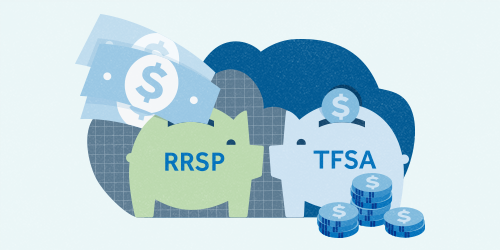Two of the most common (and best) ways to grow your savings for retirement are RRSPs and TFSAs. What are they and which one is best under which circumstances? Here’s a quick overview.
Very simply, RRSPs and TFSAs are savings plans. An RRSP is a Registered Retirement Saving Plan and it’s primarily used to invest and grow your savings for retirement. A TFSA is a Tax-Free Savings Account and while it can be used for retirement savings, it has many other uses. One of the main distinctions between the two is that with an RRSP, taxes must be paid on investment gains, but only when funds are withdrawn. With a TFSA, taxes aren't paid on investment gains, even when you withdraw funds. Both account types allow you to invest your money in a variety of ways, such as in GICs (guaranteed investment certificates), mutual funds*, or most other investment products.
The first thing to consider when deciding whether to put money toward an RRSP or TFSA is when you need the money and whether you want a tax deduction. RRSPs are a good solution if you’re thinking long-term or want a tax deduction or refund. A TFSA is a good option if you would like to withdraw money at any time before retirement as there are no tax implications.
Understanding RRSPs
RRSPs help you save for your retirement and allow you to benefit from compound interest. They are an important way to have retirement income outside of government and employer pension plans.
RRSPs have an annual contribution limit which is based on your earnings. If you don't use your contribution room in a given year, it can be carried forward.
RRSP contributions are especially helpful during high-earning years to lower your tax burden. You’ll have to pay tax when you withdraw your RRSPs during retirement, however, your income will likely be lower then, so the net gain on taxes ends up being positive.
RRSPs can also be used for more than retirement savings. Two of the biggest non-retirement benefits an RRSP can bring are helping you afford a home though the federal government's Home Buyers' Plan (HBP) and funding your education with the Lifelong Learning Plan (LLP). With both programs, you can withdraw funds from your RRSP tax-free. However, there are rules and expectations around repaying what you take out.
Understanding TFSAs
TFSAs, which were introduced in 2009, are another vehicle for saving. Because funds can be invested without any tax implications, many people use TFSAs to save for bigger expenses such as down payments for a home, emergency savings or tuition, while still benefitting from having those funds earn interest.
There’s an annual TFSA contribution limit of $6,500 as of Jan. 1, 2023, up from $6,000 in 2022.
The limit is the same for everyone and carries over each year. If you don’t contribute the maximum, you can make it up later. While you don’t get any immediate tax break from putting money in a TFSA, the benefit is that you don’t have to pay tax on withdrawals, including both your initial contribution and any investment returns.
TFSAs offer a lot of flexibility. You can reduce taxes by switching investments in taxable accounts to a TFSA, where the interest you earn will be tax-free. They can also be a good addition to retirement savings – especially if you’ve maximized your RRSP contribution room. In this case, you'd have another source of money when you retirement that can be withdrawn at any time with no tax consequences.
Get advice and get started
These are general tips and may not apply to your unique situation. RRSPs and TFSAs are both good ways to build your future and should be part of an overall financial plan, which includes tax and estate planning. Whether you’re new to investing or not, it’s always a good idea to get professional advice from an advisor who can help you make informed decisions.
If you know where you want to start, don't forget that members can invest in RRSPs and TFSAs in online banking.
Talk to an advisor Invest online
*Mutual funds and other securities are offered through Aviso Wealth, a division of Aviso Financial Inc. Commissions, trailing commissions, management fees and expenses all may be associated with mutual fund investments. Please read the prospectus before investing. Unless otherwise stated, mutual fund securities and cash balances are not insured nor guaranteed, their values change frequently and past performance may not be repeated.


